Pyin Oo Lwin is located on the western bank of the river Ayeyarwaddy. approximately 7 miles north of Mandalay. Over 1000 metres above sea-level. Pyin Oo Lwin is a popular hill station about 69km away from Mandalay.
It is well known for its colonial style houses with large compound and pine trees. eucalyptus and silver-oak abound in town. Delightfully cool and pleasant the whole year round.
Click here to see the Map of Pyin Oo Lwin
Interesting Places
KANDAWGYI BOTANICAL GARDEN
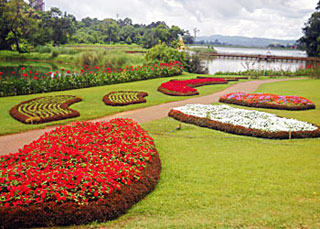
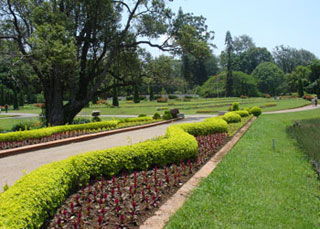
The Botanical Garden was first founded in the year 1915-16 by one British botanist named Mr. Roger who began collecting local plants and trees and cultivating them on 30 acres of land at the present site. It was only in 1919 that the Government gave official sanction to it. The original area of the Botanical Garden was 170 acres of land and 70 acres of water totaling 240 acres. With a constant supply of sufficient spring water from the great lake nearby. the plan of the Garden was laid out on the design of Kew Gardens in England. In 1920 the Forest Department issued a notification No. 207 which declared the Botanical Garden as a forest reserve and placed it under the custody of the Department. In several plots were planted 4840 trees mostly pine varieties. 575 different floral species and many exotic fruit. flower and shade trees from abroad that were acclimatized to grow in the Garden. Besides. vast meadows and several seasonal flower beds were arranged and hundreds of wild orchids from different parts of the country were collected and displayed in the Orchid Green House in the garden. The garden thus became one of the world class botanical gardens.
PWE KAUK FALL
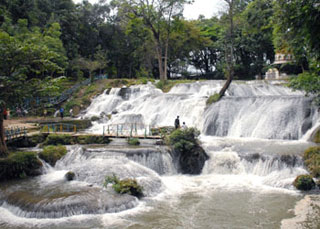
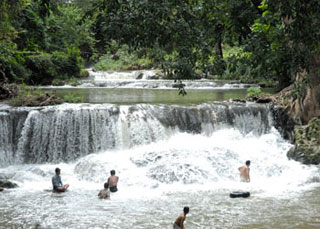
Pwe Kauk Fall is about 8km from town. It is also called Hampshire Falls in British times. It’s a very pleasant picnic spot.
PEIK CHIN MYAUNG (MAHA NANDAMU CAVE)
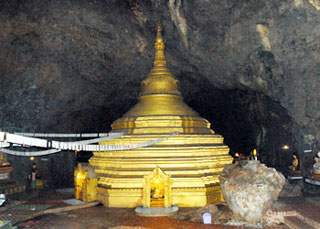
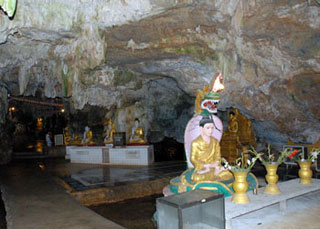
The cave is near Wetwun village 12 miles east of the town and it is three miles south of the village. easily accessible by car. The cave is at the entrance to the Peik Chin Myaung ravine. with many beautiful springs. When the rocks in the cave began to form. the place was under seawater. As lime piled up. the hillock took formation. Geologists estimate that it could be between 230 million and 310 million years old. The cave is called Peik Chin Myaung (Peik Chin Plants Ravine) as plenty of Peik Chin plants used to grow there. letting no light inside. This Great Cave of rock was formed out of a fault. As water seeped and dropped from rocks and limestone. there appeared stalactites and others in the shape of chandeliers. On entering the cave you see springs flowing from different directions. The water at some places is as deep as five feet. Water seeps from the walls of the rock; and is clean and cool. It is said that this water cures eye ailments and itching. So. pilgrims take this spring water home in bottles.
The Great Cave covers an area about 48 acres. Once inside the cave. you shiver with cold what with the springs and small waterfalls. The Buddha-to-be’s life story up to His Enlightenment is featured at appropriate places. There are also Buddha images and pagodas in corners and niches.
MAHA ANTHTOOKANTHAR PAYA
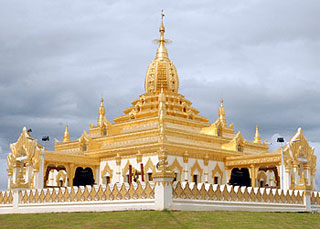

This pagoda was not planned. but just came to be. The reason for this is that 3 marble Buddha figures made in Mandalay were being transported to their planned home in China. On this journey one of the Buddha figures fell from the lorry and could not be reloaded due to its weight. After many attempts it was left behind and the other 2 were taken on their way. The Buddha image left behind. needed to be moved. but no one knew how to go about this task. A local Buddhist monk decided he would try faith. He sat for 7 days on this figure and preached to the locals and recited teachings of Buddha. After 7 days the figure was. apparently. easily lifted and placed in its current location and the local people built a pagoda as an offering to Buddha.
